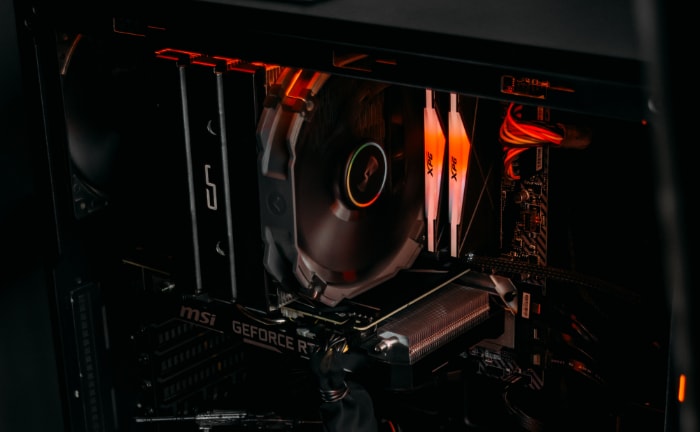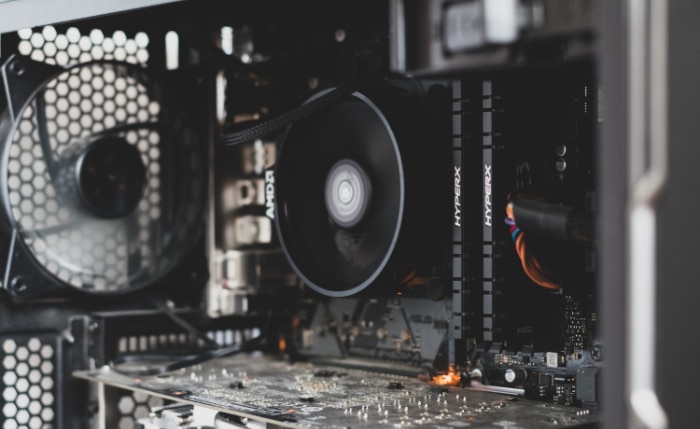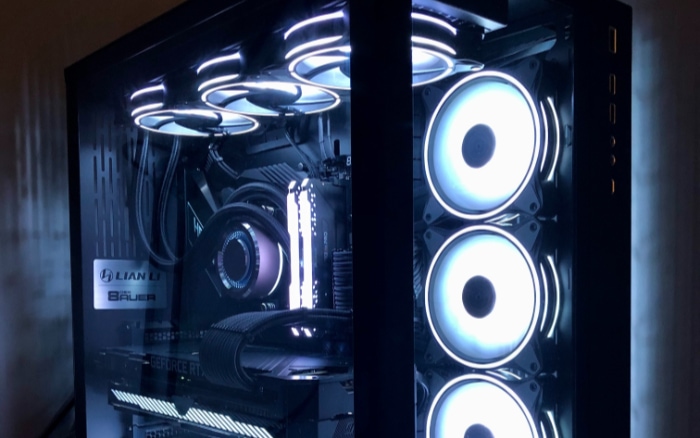How to Fix a Rattling PC Fan: A Step-by-Step Guide

A well-functioning PC fan is essential for maintaining optimal performance and ensuring the longevity of your computer. As your computer works, it generates heat, and it's the role of the PC fan to dissipate this heat, preventing overheating and potential damage to internal components.
However, over time, fans may develop issues, such as rattling noises, which can be annoying and may even indicate a more serious problem.
In this guide, we will explore the common causes of a rattling PC fan and provide you with a comprehensive, step-by-step process to diagnose and resolve the issue.
By following these instructions, you can ensure that your PC remains cool, efficient, and free of any irritating noises.
Identifying the Source of the Rattling Noise
If you're experiencing a rattling noise coming from your PC fan, it's important to identify the source of the problem before attempting to fix it. This section will guide you through the steps to identify what might be causing the issue.
Pinpointing the Source Through Active Listening
Before diving into any repair work, it's crucial to identify the precise location of the rattling noise. Start by carefully listening to your computer while it's running.
Pay close attention to the various fans within the system, such as the CPU cooler, case fans, and graphics card fans, to determine which one is causing the issue.
Visually Inspecting the Fan
Once you have narrowed down the location of the problematic fan, use a flashlight to inspect it more closely. Look for any signs of physical damage, such as bent or broken fan blades, as well as debris that may be obstructing the fan's movement.
Additionally, keep an eye out for loose screws or components that may be contributing to the rattling noise.
Stopping the Fan Momentarily for Confirmation
To confirm that the fan in question is indeed the source of the rattling noise, you can momentarily stop it using a non-conductive object, such as a plastic pen or a wooden pencil.
Gently press the object against the fan's hub to slow it down or stop it temporarily, being careful not to apply excessive force. If the rattling noise stops when the fan is not spinning, you can be confident that you have identified the correct fan to troubleshoot.
Safely Turning Off and Unplugging Your PC
Before starting any repairs on your PC fan, it's essential to turn off and unplug your computer to avoid any potential damage or harm. This section will provide you with the necessary steps to safely shut down and unplug your computer before beginning any repairs.
Shutting Down Your Computer
Before attempting any repairs or maintenance, it is essential to shut down your computer properly. Save any open files and close all running applications to prevent data loss.
Then, navigate to the operating system's power options and select “Shut Down” to power off your computer completely.
Unplugging the Power Cable
With your computer shut down, locate the power cable connected to the back of the PC. Carefully unplug the cable from the power supply unit (PSU) to ensure that no electrical current is flowing through the system while you work on it.
It is also a good idea to unplug any other cables connected to your PC, such as USB devices, Ethernet cables, or display connections, to avoid any accidental damage.
Grounding Yourself to Prevent Electrostatic Discharge
Electrostatic discharge (ESD) can cause irreversible damage to sensitive electronic components within your computer. To protect your PC from potential harm, it is important to ground yourself before touching any internal parts.
You can do this by using an anti-static wrist strap, which connects to a grounded object, or by frequently touching a grounded, unpainted metal surface, such as the metal frame of your computer case or a nearby radiator.
This will help dissipate any static electricity buildup and reduce the risk of ESD-related damage.
Cleaning the PC Fan
If your PC fan is rattling, it may be due to dust and debris buildup on the fan blades or in the surrounding area. In this section, you will learn how to clean your PC fan to remove any accumulated dust and debris.
Removing Dust and Debris with Compressed Air
Dust and debris accumulation can contribute to a rattling noise and reduce the efficiency of your PC fan. To clean the fan, use a can of compressed air to blow away dust particles from the fan blades, the fan casing, and the surrounding area.
Be sure to hold the can upright and maintain a distance of approximately 6 inches from the components to avoid damaging them with excessive air pressure.
Wiping Down Fan Blades with a Microfiber Cloth
For a more thorough cleaning, gently wipe the fan blades with a clean, lint-free microfiber cloth. This will help remove any stubborn dust or debris that may have adhered to the blades.
Be cautious while handling the blades, as applying too much pressure can potentially bend or break them.
Cleaning the Fan Casing and Surrounding Area
After addressing the fan blades, use the microfiber cloth to clean the fan casing and the surrounding area within the computer case.
This will not only help eliminate the rattling noise but also improve overall system airflow, keeping your PC cooler and more efficient. Remember to be gentle when cleaning these components to avoid causing any unintentional damage.
Inspecting and Tightening Loose Screws
Loose screws can often cause a rattling noise in your PC fan. In this section, you'll learn how to inspect the screws on your PC fan and determine if they're loose.
Examining the Fan Mounting Screws
Loose screws can cause a rattling noise as your PC fan operates. Carefully inspect the mounting screws that secure the fan to the computer case or heatsink. Look for any signs of looseness or misalignment that could be contributing to the noise.
Tightening Loose Screws with a Screwdriver
If you find any loose screws, use a screwdriver with the appropriate head type (typically Phillips or flathead) to gently tighten them.
Make sure not to overtighten the screws, as this could damage the fan or the mounting brackets. Apply just enough pressure to secure the fan firmly in place without causing strain on the components.
Checking for Loose Components Near the Fan
In addition to the fan mounting screws, other loose components within your PC could be causing a rattling noise. Inspect the surrounding area for any loose wires, cables, or other hardware that may be coming into contact with the fan during operation.
Secure these components using cable ties or adhesive cable clips, ensuring they are neatly arranged and clear of the fan blades.
Replacing Damaged or Worn Components

If your PC fan is damaged or has worn components, it may be time to replace it. In this section, you'll learn how to identify damaged or worn components and how to replace them with new ones.
Identifying Worn Bearings or Damaged Blades
If cleaning and tightening screws do not resolve the rattling noise, it is possible that the fan has worn bearings or damaged blades. Worn bearings often produce a grinding noise, while damaged blades can cause imbalanced rotation, leading to rattling.
Carefully examine the fan for these issues, paying close attention to the fan hub, which houses the bearings, and the condition of the blades.
Purchasing the Appropriate Replacement Parts
Once you have determined the cause of the issue, you will need to purchase the appropriate replacement parts. For worn bearings, you may need to replace the entire fan, as the bearings are often integrated into the fan assembly.
If you have damaged blades, you might be able to replace just the blades or the entire fan, depending on the specific fan model. Make sure to purchase parts that are compatible with your PC's make and model to ensure a proper fit and functionality.
Replacing the Damaged Components or Entire Fan
With the necessary replacement parts in hand, proceed to remove the damaged fan or fan blades. Disconnect the fan's power cable from the motherboard or power supply, and carefully unscrew the fan from its mounting position.
Replace the damaged components or the entire fan, as required, and secure the new fan in place with the mounting screws. Don't forget to reconnect the fan's power cable to the appropriate connector on the motherboard or power supply.
Reassembling and Testing Your PC
After fixing your rattling PC fan, it's important to reassemble your computer and test it to ensure that the issue has been resolved.
Reconnecting the Fan and Closing the PC Case
With the fan repair or replacement complete, make sure all cables and components are properly connected and secured within your PC. Neatly arrange any cables to ensure optimal airflow and reduce the risk of future issues.
Once everything is in place, close your computer case by reattaching the side panel and fastening any screws or latches as necessary.
Plugging In and Turning On Your Computer
Reconnect all the cables you unplugged earlier, such as the power cable, USB devices, Ethernet cables, and display connections. Ensure that each connection is secure and properly inserted. Plug the power cable into a suitable outlet and turn on your computer using the power button.
Listening for Any Remaining Rattling Noises
As your computer starts up, pay close attention to the sound it produces. The rattling noise should be resolved if you have properly cleaned, tightened, or replaced the necessary components.
If you still hear a rattling noise, you may need to reinspect your PC to determine if there are any other contributing factors, such as additional loose components or a separate fan issue.
Preventative Maintenance Tips
To prevent future rattling PC fan issues, it's important to perform regular maintenance on your computer. In this section, you'll learn some helpful tips and tricks for keeping your PC in good working order and preventing issues from arising in the future.
Regularly Cleaning Your PC
One of the best ways to prevent rattling noises and other fan-related issues is to keep your computer clean. Schedule routine cleaning sessions, ideally every three to six months, to remove dust and debris from your PC's interior.
Use compressed air to clean the fans, heatsinks, and other components, ensuring optimal airflow and performance.
Ensuring Proper Ventilation and Airflow

Good ventilation and airflow are essential for maintaining a cool and efficient PC. Make sure your computer is placed in a well-ventilated area with enough space around it for air circulation.
Avoid placing your PC on carpeted surfaces or in cramped spaces, as this can restrict airflow and cause dust to accumulate more quickly.
Additionally, consider adding more case fans or upgrading your cooling solution if necessary to maintain ideal temperatures.
Inspecting Fans for Wear and Tear Periodically
Regularly inspect your PC's fans for signs of wear and tear, such as damaged blades or worn bearings. Catching these issues early can prevent more severe problems, like overheating or component failure, and save you time and money in the long run.
If you notice any signs of wear, consider replacing the affected fan or its components before the issue escalates.
By following these preventative maintenance tips, you can extend the lifespan of your computer's fans and ensure that your PC remains cool, efficient, and free of any irritating rattling noises.
Conclusion
In conclusion, addressing a rattling PC fan is essential for maintaining optimal performance and ensuring the longevity of your computer.
By following the comprehensive, step-by-step guide provided in this article, you can diagnose and resolve the issue, whether it requires cleaning, tightening screws, or replacing damaged components.
Remember, regular maintenance and inspection of your PC's fans and other components can prevent more severe problems and save you time and money in the long run.
By keeping your PC clean, well-ventilated, and free of any irritating noises, you can enjoy a smoother, more efficient computing experience.


